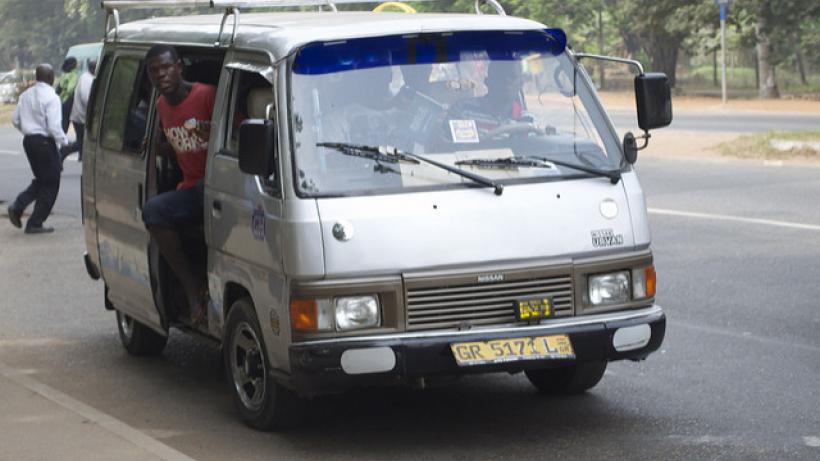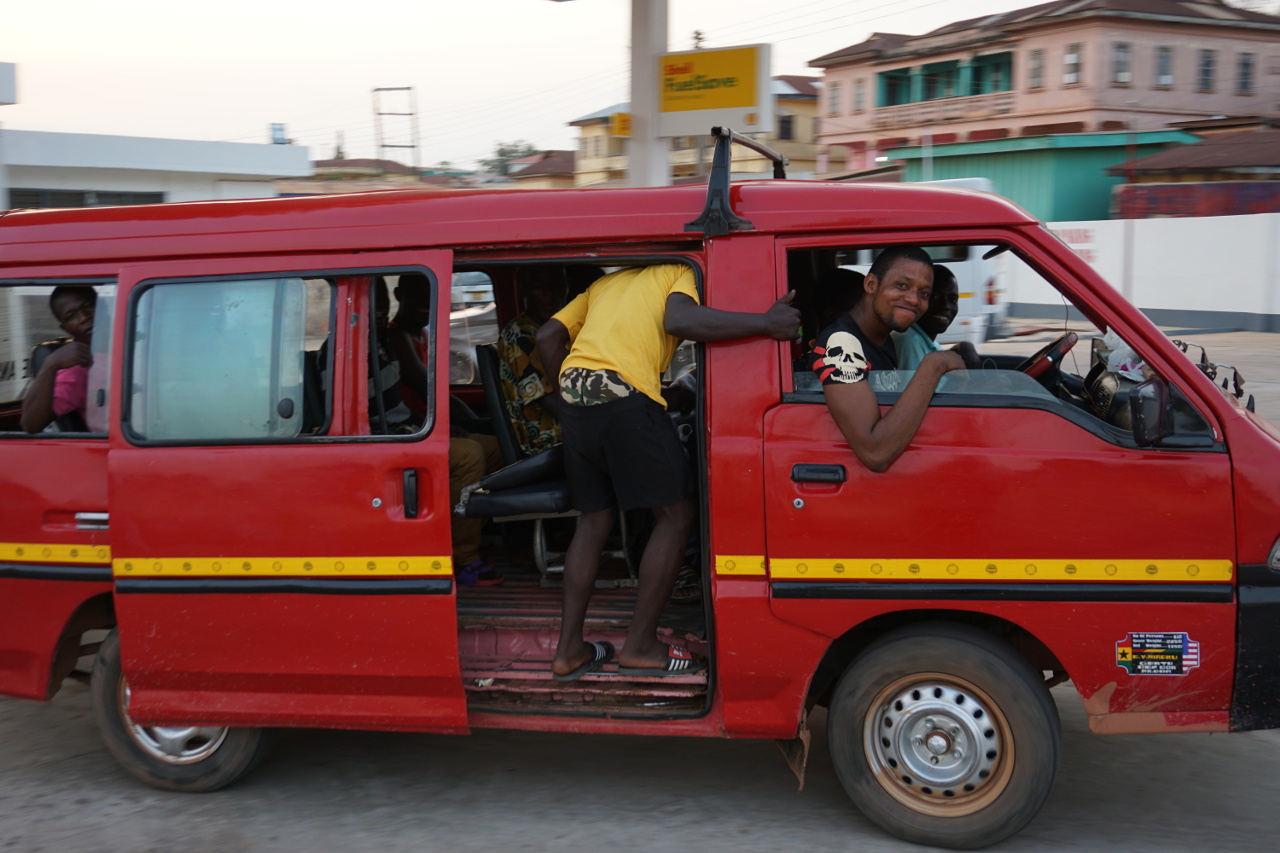
Transport and job accessibility: Towards a competitive and inclusive Accra
A working age individual can only reach up to 32% of formal jobs by tro-tro within 60 minutes. Poor connectivity harms labour and firm outcomes. There is a need for investment in public transit, land-use reforms and low-income urban housing policies.
Cities in sub-Saharan Africa (SSA) are urbanising at an unprecedented pace. As a result, they have often expanded horizontally in an uncoordinated fashion, and large shares of urban dwellers face inadequate access to public services and infrastructure. A recent report by the World Bank (2017) characterises African cities as costly, disconnected and crowded.
City expansion and job accessibility: Accra
Accra, Ghana’s capital, is no exception to this trend. Being one of the fastest growing cities in SSA, its population has more than doubled in less than two decades. However, the city’s resulting physical expansion has brought about many problems related to efficiency and inclusion (i.e. slums, lack of basic public services, insufficient transport infrastructure). Congestion as well as long and costly commutes are among these many challenges (Figure 1), and a key aspect to address to achieve sustainable urban development.
This column looks at the question of accessibility to jobs in Accra. It provides a diagnostic of employment accessibility across Accra’s neighbourhoods for the main commuting modes, and characterizes the relationship between accessibility, individual labour market outcomes and firm’s hiring capacities.

Figure 1: Congestion in Accra. Image credit: Brunodecuk, 2013
Connectivity, growth and inclusion
Well-functioning cities reduce distance between people and economic opportunities (Avner and Lall, 2016). As a result, agglomeration economies and productivity growth arise in highly connected cities (Duranton and Puga, 2004). Poor connectivity is thus an obstacle for growth.
Firms:
Here, we focus on cities as labour markets (Bertaud, 2014). From the point of view of firms, poor connectivity limits the effective size of the labour pool, preventing successful matching between workers and firms, and leading to a misallocation of productive resources and economic inefficiencies. Further, disconnected and costly cities deter entrepreneurs from investing in manufacturing and the production of tradable goods and services (Venables, 2017), hampering potential agglomeration economies.
Workers:
From the workers’ side, poor employment accessibility deters labour market participation and formal employment as it can increase reservation wages and information and search frictions (Gobillon and Selod, 2014). Households may compromise their living conditions to be close to economic opportunities (Galiani et al., 2016). In overcrowded and sprawling urban areas in developing countries, where central areas concentrate economic opportunities, while peripheral low-income areas offer only limited formal job opportunities, the question of access to jobs is also a question of inclusion.
Urban commuting patterns
The Accra Metropolitan Area is the economic hub of the Greater Accra Region, as well as the rest of the country. Still, most urban jobs are concentrated in low value-added informal services (World Bank, 2015). The city exhibits a marked monocentric city pattern (Figure 2). In 2009, UN-Habitat estimated that 65% of vehicular movements were concentrated towards the Central Business District (CBD).

Figure 2: Distribution of job-related amenities, data obtained from OpenStreetMaps (OSM).
More than one quarter of the close to 4 million inhabitants of the city commute daily to the city for various socio-economic activities. Long daily and regular commuting between residential areas, the CBD, or industrial areas, characterises Accra’s city life. According to the National Transport Survey 2012, the average commuting time in the Greater Accra Metropolitan Area (GAMA) is 110 minutes, for an average distance of 3.28km. Half of commuting workers in the GAMA cite bad roads as the main limitation to access the workplace, and a quarter cite heavy congestion as the main barrier. Among those actively looking for jobs, more than 50% report inaccessibility to the workplace as their main challenge.
High‐capacity mass transport is almost non-existent in Accra (the exception is the recently launched Bus Rapid Transit (BRT) system, in November 2016). More than 75% of city dwellers use informal shared minibus taxis called tro-tro for commuting (Figure 3). Tro-tros are licensed by the Ministry of Transport. However, routes and fares are determined through their own unions. While formal routes and stops exist, they can be boarded and disembarked anywhere along the route, heavily contributing to congestion. Only around 13% of city dwellers chooses to walk, while the remainder use private cars for their daily trips to work (World Bank 2017). These average patterns hide significant disparities as low and middle-income households disproportionately walk or use tro-tros as their preferred mode of transport (World Bank 2015).

Figure 3: Using Tro-tros in Accra. Image credit: Ghanaweb, 2016
The study: Unequal access to jobs and labour market impacts
Methodology:
We follow standard practice and define accessibility as the share of economic opportunities that can be accessed by working age individuals in their neighbourhood of residence in Accra in a given time-frame, using
The study reveals sharp disparities with respect to job accessibility by commuting mode. While most jobs can be reached by car within 60 minutes from any neighbourhood, access to jobs by the more popular tro-tro or walking is highly unequal across Accra’s neighbourhoods (Figure 4). Together these two modes account for more than 80% of Accra’s residents commuting. Yet, on average a working age individual can only reach between 20 to 32% of all formal job opportunities by tro-tro within 60 minutes. This is relatively on par with Nairobi, where users of the equivalent ‘matatu’ can only access 20% of jobs within 60 minutes (Avner and Lall, 2016). If commuting by foot, workers cannot access more than 5 to 7% of formal jobs within the same time (Table 1).

Figure 4: Job Accessibility for Accra and proximity within 60 minutes by main modes of commute (Note the white polygon is a natural reserve that we have excluded to avoid measurement error).
The study further investigates the extent to which labour and firms’ outcomes are associated with employment accessibility. Relying on the micro census data (2010), we relate one’s performance in the labour market to the job accessibility in their neighbourhood of residence. Our econometric findings point towards a positive relationship between job accessibility and satisfactory labour outcomes. Better connected individuals appear more likely to be employed and work in the formal sector. Conversely, individuals facing obstacles to reach job opportunities are more likely to be self-employed and work in the informal sector. This is consistent with self-employment and the informal sector being a constrained occupational choice for individuals lacking viable alternatives.
The predominance of employment in the low-wage non-tradable informal services sector seems to reflect the barriers to urban agglomeration economies. Interestingly, we find women to be more sensitive to accessibility. This supports evidence found in other developing countries that women tend to be less mobile (Baker et al., 2015) and tend to have less bargaining power in their household residential location decisions.
Supporting these findings, the study also examines the influence of an effective accessible labour force on formal firms’ capacity to recruit suitable workers using micro enterprise data (Jobs Survey 2006). Here, we also see firms located in neighbourhoods with a higher labour pool reach being less likely to report unfilled vacancies. On the whole, the analysis we conduct, while descriptive, strongly suggests that Accra’s lack of efficient connectivity harms labour and firm economic outcomes.
Tackling accessibility to increase competitiveness and inclusion
Results in this study reveal important spatial disparities in terms of access to employment opportunities across the various neighbourhoods of Accra by the main mode of commute (tro-tro). The lack of connectivity we document is found to affect both workers and firms. Results also suggest women may be more negatively affected by the lack of accessibility, bringing forward the question of designing gender-specific policies.
There are many ways to influence accessibility within cities including, but not limited, to investments in public transit, reforming land-use regulations and the careful design of low-income housing policies. Increasing accessibility is not only important for improving the living conditions of city dwellers, it is also essential to stimulate agglomeration economies and economic growth in the longer run. Poor employment matching can be harmful for the economic development of Accra as labour and capital productive resources are not allocated to their most efficient use. At an aggregate level, agglomeration economies, manufacturing employment growth, and urban productivity are hampered by the lack of accessibility and the city-wide disconnect between workers and formal firms.
References:
Abekah-Nkrumah, G., Asuming, P. and Telli, H. (2015). Urban transport systems and commuter mode choices: A field experiment in Ghana, the International Growth Centre. Accessible: https://www.theigc.org/project/urban-transport-systems-commuter-mode-choices-field-experiment-ghana/
Avner, P. and Lall, S. (2016). Matchmaking in Nairobi: The Role of Land Use. Policy Research Working Paper, No. 7904. World Bank, Washington, DC. Accessible: https://openknowledge.worldbank.org/handle/10986/25803
Bertaud, A. (2004). Cities as Labor Markets, Working Paper 2, Marron Institute. Accessible: http://marroninstitute.nyu.edu/uploads/content/Cities_as_Labor_Markets.pdf
Duranton, G. and Puga, D (2004). Volume 4: Handbook of Regional and Urban Economics: Chapter 48 - Micro-Foundations of Urban Agglomeration Economies, Elsevier. Accessible: http://www.sciencedirect.com/science/article/pii/S1574008004800051
Embassy of France in Ghana (2016). Mobility and Development: launch of the Accra TroTro Apps Challenge. Accessible: https://gh.ambafrance.org/Mobility-and-Development-launch-of-the-Accra-TroTro-Apps-Challenge
Galiani, S., Gertler, P. J., Undurraga, R., Cooper, R., Mart´ınez, S. and Ross, A. (2016). “Shelter from the Storm: Upgrading Housing Infrastructure in Latin American Slums”, Journal of Urban Economic. Accessible: http://www.sciencedirect.com/science/article/pii/S0094119016300572
Ghana Statistical Service, Office of the President (2008). Ghana Job Tracking Survey. Accessible: http://www.statsghana.gov.gh/nada/index.php/catalog/6
Ghana Statistical Service and the Minnesota Population Center (2010). Ghana Population and Housing Census 2010 - IPUMS Subset, University of Minnesota Ghana. Accessible: http://microdata.worldbank.org/index.php/catalog/2151/sampling
Gobillon, L. and Selod, H. (2014). Spatial Mismatch, Poverty and Vulnerable Populations, Handbook of Regional Science, Springer. Accessible: https://ideas.repec.org/p/hal/journl/halshs-00754821.html
Government of Ghana (2016). Buses rapid transit to commence in November. Accessible: http://www.ghana.gov.gh/index.php/media-center/news/1437-buses-rapid-transit-to-commence-in-novemberGovernment of Ghana (2012). Second National Household Transport Survey Report,
Lall, S. V., Henderson, J. V. and Venables, A. J. (2017). Africa's Cities: Opening Doors to the World. Washington, DC: World Bank. Accessible: https://openknowledge.worldbank.org/handle/10986/25896
Ministry of Roads and Highways (2012). Ministry of Transport and Ghana Statistical Service. Accessible: http://www.statsghana.gov.gh/docfiles/publications/Second%20National%20Household%20Transport%20Survey%20Report%202012.pdf
Muggah, R. and Kilcullen, D (2016). These are Africa’s fastest-growing cities – and they’ll make or break the continent, World Economic Forum, Accessible: https://www.weforum.org/agenda/2016/05/africa-biggest-cities-fragility/
Venables, A. (2017). “Breaking into tradables: Urban form and urban function in a developing city”, Journal of Urban Economics, 2017, vol. 98. Accessible: https://econpapers.repec.org/article/eeejuecon/v_3a98_3ay_3a2017_3ai_3ac_3ap_3a88-97.htm
World Bank (2015). Rising through cities in Ghana: urbanization review - overview report. Washington, D.C.: World Bank Group. Accessible: http://documents.worldbank.org/curated/en/613251468182958526/Rising-through-cities-in-Ghana-urbanization-review-overview-report
World Bank (2005). Urban Poverty and Transport: The Case of Mumbai, Working Paper, Washington, D.C.: World Bank Group. Accessible: https://openknowledge.worldbank.org/handle/10986/8602

